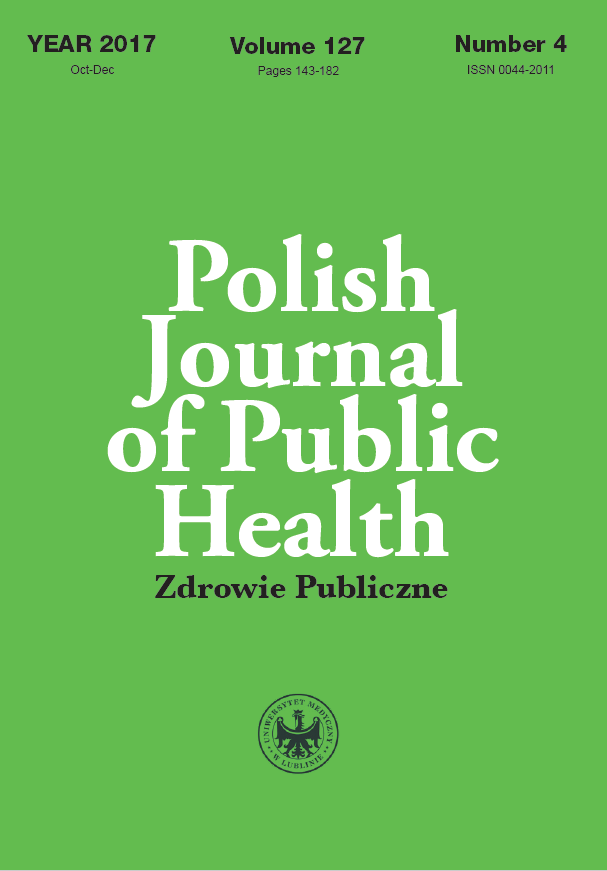Effect of renalase (RNLS) gene polymorphisms (rs1088700 and rs2576178) on plasma RNLS level in hemodialyzed patients affected by arterial hypertension and coronary artery disease
DOI:
https://doi.org/10.1515/pjph-2017-0031Keywords:
cardiovascular abnormalities, renal dialysis, polymorphism, geneticsAbstract
Introduction. We have previously reported that rs10887800 and rs2576178 renalase (RNLS) single nucleotide polymorphisms (SNPs) are associated with the susceptibility to arterial hypertension (HY) and coronary artery disease (CAD) in hemodialyzed patients (HD). However, the underlying mechanism of this link remains undefined.
Aim. In the present study we examine the influence of above-mentioned RNLS gene variants on plasma renalase level in subgroups of HD patients affected by HY and CAD.
Material and methods. In total, 309 hemodialyzed patients participated in the study (157 males and 152 females, mean age 64.1±14.10 years). Rs10887800 and rs2576178 RNLS gene polymorphisms were genotyped using PCR-RFLP method. Plasma RNLS level was assessed by ELISA (USCN Life Science Inc., Wuhan, China). The data were analyzed using SPSS Statistics 23.
Results. Regarding rs10887800 polymorphism, hypertensive AA homozygotes had significantly lower plasma RNLS level (28.93±9.94 µg/mL) compared to AG (34.06±12.79 µg/mL) and GG carriers (36.54±12.01 µg/mL), p=0.002. Among CAD patients no differences in plasma RNLS concentrations between rs10887800AA, AG and GG carriers were observed (31.52±10.95 µg/mL, 34.75±13.37 µg/mL, 34.44±13.10 µg/mL, respectively), p=0.615. For the rs2576178 variant, both HY and CAD participants did not differ in terms of plasma RNLS levels with regard to the particular genotypes, p>0.050.
Conclusion. Obtained results extend our previous findings and indicate for the first time that rs10887800 RNLS gene variant modifies the level of plasma RNLS in hemodialyzed patients with HY but not in those with CAD. The study provides, thus, a new insight into the potential mechanisms through which RNLS gene variants modulate the risk of cardiovascular diseases among patients with end-stage kidney disease.
References
1. Go AS, Chertow GM, Fan D, et al. Chronic kidney disease and the risks of death, cardiovascular events, and hospitalization. N Engl J Med. 2004;351:1296-305.10.1056/NEJMoa04103115385656
2. Burmeister JE, Mosmann CB, Costa VB, et al. Prevalence of cardiovascular risk factors in hemodialysis patients – The CORDIAL Study. Arq Bras Cardiol. 2014;102:473-80.10.5935/abc.20140048405145024759948
3. Weiner DE, Tabatabai S, Tighiouart H, et al. Cardiovascular outcomes and all-cause mortality: exploring the interaction between CKD and cardiovascular disease. Am J Kidney Dis. 2006;48:392-401.10.1053/j.ajkd.2006.05.02116931212
4. Longenecker JC, Coresh J, Powe NR, et al. Traditional cardiovascular disease risk factors in dialysis patients compared with the general population: The CHOICE Study. J Am Soc Nephrol. 2002;13:1918-27.10.1097/01.ASN.0000019641.41496.1E12089389
5. Desir GV. Regulation of blood pressure and cardiovascular function by renalase. Kidney Int. 2009;76:366-70.10.1038/ki.2009.16919471322
6. Stec A, Semczuk A, Furmaga J, et al. Polymorphism of the renalase gene in end-stage renal disease patients affected by hypertension. Nephrol Dial Transplant. 2012;27:4162-6.10.1093/ndt/gfr29321617193
7. Stec A, Ksiazek A, Buraczynska M. Rs10887800 renalase gene polymorphism is associated with an increased risk of coronary artery disease in hemodialyzed patients. Int Urol Nephrol. 2016;48:871-6.10.1007/s11255-016-1270-7489492127023477
8. K/DOQI clinical practice guidelines for cardiovascular disease in dialysis patients. Am J Kidney Dis. 2005;45(4 Suppl 3):S1-153.10.1053/j.ajkd.2005.01.019
9. Stec A. Rs10887800 renalase gene polymorphism influences the level of circulating renalase in patients undergoing hemodialysis but not in healthy controls. BMC Nephrol. 2017;18:118.10.1186/s12882-017-0543-4537972028372594
10. Desir GV. Renalase deficiency in chronic kidney disease, and its contribution to hypertension and cardiovascular disease. Curr Opin Nephrol Hypertens. 2008;17:181-5.10.1097/MNH.0b013e3282f521ba18277152
11. Baraka A, El Ghotny S. Cardioprotective effect of renalase in 5/6 nephrectomized rats. J Cardiovasc Pharmacol Ther. 2012;17:412-6.10.1177/107424841244697722626958
12. Desir GV, Tang L, Wang P, et al. Renalase Lowers Ambulatory Blood Pressure by Metabolizing Circulating Adrenaline. J Am Heart Assoc. 2012;1: e002634.10.1161/JAHA.112.002634348733823130169
13. Zbroch E, Malyszko J, Malyszko JS, et al. Renalase, a novel enzyme involved in blood pressure regulation, is related to kidney function but not to blood pressure in hemodialysis patients. Kidney Blood Press Res. 2012;35:395-9.10.1159/00033817822539018
14. Zbroch E, Malyszko J, Malyszko J, et al. Renalase in peritoneal dialysis patients is not related to blood pressure, but to Dialysis Vintage. Perit Dial Int. 2012;32:348-51.10.3747/pdi.2011.00118352544622641741
15. Oguz EG, Gursoy GK, Yayar O, et al. Increased serum renalase in hemodialysis patients: is it related to left ventricular hypertrophy? Ren Fail. 2016;38:1180-6.
16. Dziedzic M, Petkowicz B, Bednarek-Skublewska A, et al. Relationship between renalase and N-terminal pro-B-type natriuretic peptide (NT pro-BNP) in haemodialysis patients. Ann Agric Environ Med. 2014;21:132-5.
17. Shemin D, Bostom AG, Laliberty P, et al. Residual renal function and mortality risk in hemodialysis patients. Am J Kidney Dis 2001;38:85-90.10.1053/ajkd.2001.2519811431186
18. Zbroch E, Musialowska D, Koc-Zorawska E, Malyszko J. Age influence on renalase and catecholamines concentration in hypertensive patients, including maintained dialysis. Clin Interv Aging. 2016;11:1545-50.10.2147/CIA.S106109509452727822026
19. Manning AK, Hivert MF, Scott RA, et al. A genome-wide approach accounting for body mass index identifies genetic variants influencing fasting glycemic traits and insulin resistance. Nat Genet 2012;44:659-69.10.1038/ng.2274361312722581228
Downloads
Published
Issue
Section
License
Copyright (c) 2018 Polish Journal of Public Health

This work is licensed under a Creative Commons Attribution-NonCommercial-NoDerivatives 3.0 Unported License.


